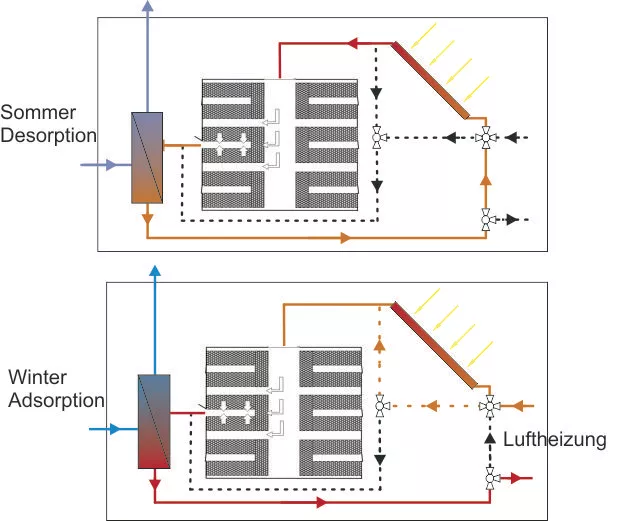Researchers at the University of Stuttgart are preparing to test a solar heating system capable of long term storage as part of "Solspaces," a three-year project that kicked off in March 2012. The heating concept uses a solar thermal system in conjunction with a sorption tank for storing heat from solar collectors throughout the warmer months that can then be released when the mercury drops.
The Solspaces concept has the potential to reduce the required storage space for solar heating systems and address the issue of heat retention. It involves a thermochemical heat storage tank with three to four times the energy density of water and improved thermal insulation, enabling more compact storage with less susceptibility to heat loss than conventional solar thermal systems relying on water as the heat storage medium.
Integral to the process is the microporous mineral zeolite, which boasts high energy density, low drying temperature and the ability to uptake large amounts of water vapor. During winter, the zeolite acts as a sorbent, adsorbing humidity from the moist air flowing through the reservoir. The binding of the water vapor with the sorbent produces heat energy, which is used to heat the building.
In the summer months, the process is reversed with solar collectors heating the air flowing through the reservoir to 180° C (356° F). This desorbs the water molecules, allowing the sorbent to dry out and be ready to store heat once again. The team says this process has the potential to almost entirely eliminate heat loss as it doesn't require water in the tank to be maintained at a high temperature year-round.

The experiment will be conducted on a prefabricated compact house known as "Flying Spaces" that was provided by German company SchwörerHaus. The building comes in sizes of up to 48 sq m (516 ft sq) in size and was selected for the experiment due to its volume to surface ratio, which according to the research team, would make the findings of the project applicable to buildings of larger size.
The "Flying Spaces" buildings can be purchased with a conventional heating system, which the research team will initially study before installing the newly-developed solar thermal system so as to accurately determine its effectiveness compared to that of the traditional system.
“With the new research building at the University of Stuttgart we have the possibility of realizing a solar heating system with which the heat requirements of a building can be covered throughout the entire year”, said the Head of the Research and Test Centre for Solar Systems, Dr Harald Drück and Project Leader Dr Henner Kerskes.
Germany's Federal Ministry of Environment has provided the project with €650,000 (US$881,000) in funding, with its completion expected in February 2015.
Source: University of Stuttgart





